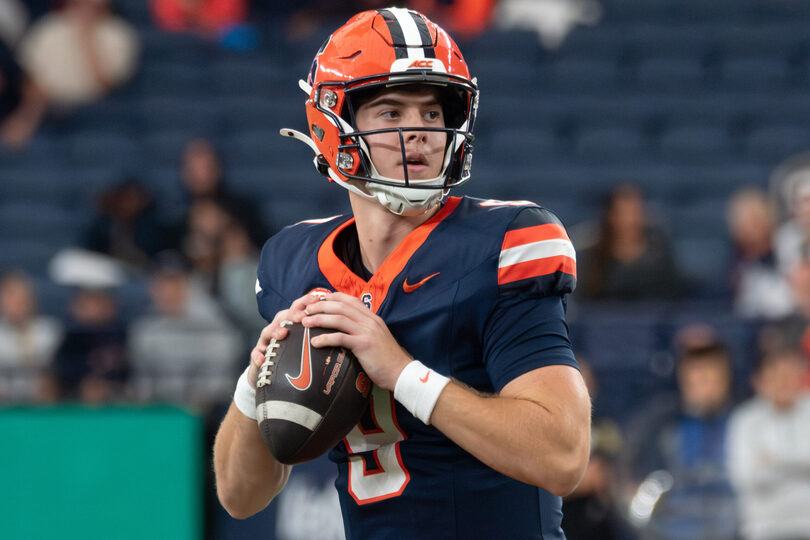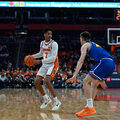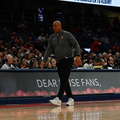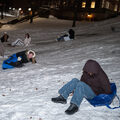Steve Angeli’s ‘main obstacle is to be patient,’ renowned orthopaedic surgeon says

Steve Angeli will miss the rest of the season with a torn Achilles. Dr. Nicola Maffulli offered a detailed look at Angeli’s recovery process. Jacob Halsema | Staff Photographer
Get the latest Syracuse news delivered right to your inbox. Subscribe to our sports newsletter here.
Steve Angeli laid on the Memorial Stadium turf with both hands on his helmet. He grimaced in pain as athletic trainers tended to the calf and ankle area of his left leg.
Seconds earlier, Angeli had tried to scramble out of the pocket before collapsing to the ground. He had already suffered a first-quarter scare but got up under his own power.
This time, he didn’t. Angeli couldn’t put any weight on his leg as trainers carried him off the field.
A non-contact injury like Angeli’s had the makings of a torn Achilles. The quick grab of the calf, the painful nature and the inability to put weight on it spelled doom. At that moment, it was hard not to assume the worst. After Syracuse’s 34-21 win over Clemson, Fran Brown said Angeli would “be out a few weeks.”
However, Syracuse’s worst fears were confirmed Sunday when ESPN’s Pete Thamel reported that Angeli tore his Achilles, sidelining him for the season. It’s one of the toughest injuries in sports due to its severity and lengthy recovery time.
The Daily Orange spoke with Dr. Nicola Maffulli, renowned consultant orthopedic surgeon, about the nature of the injury, the surgical repair, the rehab process and the post-injury outlook.
Here’s what he had to say:
What happens when you tear your Achilles?
The Achilles tendon is the strongest tendon in the human body, Maffulli said. He said it can sustain up to 17 times someone’s body weight, meaning Angeli — who weighs 212 pounds — can withstand nearly 4,000 pounds of pressure.
Maffulli added that when the tendon ruptures, it’s likely there were “gigantic changes” that the patient is unaware of, which is the most common occurrence.
“Typically, the injury occurs because the ankle muscles are subjected to what is called an eccentric force,” Mafulli said. “So the calf muscles contract while the tendons are lengthening. You can imagine that an enormous force is generated in this case, and at this stage, the Achilles tendon snaps.”
Over the past two years, National Football League quarterbacks Aaron Rodgers, Deshaun Watson and Kirk Cousins have all torn their Achilles. In just the last two weeks, running backs Austin Ekeler (Washington Commanders) and Najee Harris (Los Angeles Chargers) have suffered the same injury.
It’s become increasingly common in other sports. National Basketball Association standouts like Tyrese Haliburton, Jayson Tatum and Damian Lillard all experienced the same fate during the Playoffs, causing NBA Commissioner Adam Silver to investigate the issue.
Achilles injuries are often marked by a visible pop. That happened to Haliburton when he suffered the injury during Game 7 of the NBA Finals this season. It was also clear when Kevin Durant went down during the 2019 Finals. When Angeli dropped down on Saturday, the telltale sign wasn’t there.
“Some people report that they feel as if they’ve been kicked at the back of their ankle, and they hear a crackling whip,” Maffulli said.
“The classical thing is that either they’re trying to push off or they’re landing from a jump and unfortunately, both of them are fairly common occurrences in American football,” he added.
Surgery and recovery
Angeli announced on social media Tuesday that he underwent surgery to repair his torn Achilles. Maffulli explained multiple types of procedures can be done.
In North America, the surgery varies. There are open techniques, which use large incisions to look at the Achilles tendon before it’s stitched back up. Others use the park device, or an Achillion device, a suture-guiding system designed to repair the tendon.
Post-surgery, patients are placed in a cast for a few weeks and then in a boot afterward. Once the cast is removed, Maffulli said the rehabilitation process begins with simple ankle rotations. Avoiding ankle pulls early in rehab is crucial, since overstretching can weaken the tendon.
“The thing nowadays, physical therapy is task-based, not time-based. So if you want to regain a good thing, good motion, especially the subtalar, join the joint below the ankle, which allows the foot to move in and out,” Mafulli said. “Especially in American football, where (players) are very hard and fast and frequent, change of direction is very crucial to develop that particular motion back.”
Maffulli explained that isometric training is important to recover, which can involve seated calf raises and resistance band exercises. By three months — when the tendon starts to mature — plyometric exercises of the calf muscles are introduced.
Angeli won’t be able to run for at least four months, but if everything goes right, he can return to the field in six months, according to Maffulli.
The timeline aligns with Brown’s assessment of Angeli, indicating that the goal is for Angeli to be ready for Syracuse’s 2026 spring practices or soon after.
“The major obstacle is to be patient,” Maffulli said. “You need to give time to your Achilles tendon and to heal all the muscles around there to readapt to high-level playing now.”
Playing after Achilles tears
Coming back from an Achilles injury as a quarterback is an interesting proposition. Angeli injured his left leg, which he plants on. While he’ll continue to apply pressure to that leg when he returns to the field, Maffulli said only about 5% of patients re-injure themselves.
Performance-wise, Rodgers (39 at the time of injury) and Cousins (36) came back with mixed results. Rodgers threw for nearly 4,000 yards last season with 28 touchdowns and 11 interceptions, although the New York Jets finished 5-12. Cousins struggled, tossing 16 interceptions in 14 games for the Atlanta Falcons before getting benched for rookie Michael Penix Jr.
It’s difficult to speculate on Angeli’s performance post-injury. It’s a rare occurrence at the college level. Thomas Sirk did it while at Duke in 2016 and transferred to East Carolina for his last season of eligibility. He threw for less than 2,000 yards with as many touchdowns (nine) as interceptions.
Angeli’s performance may be dictated by his rehab, Maffulli said. If that goes well, rehab often provides a baseline for athletes to build upon. Studies show that even 10 years after an Achilles tear, some people who think their leg is fine experience a strength deficit — though that’s not always the case, Maffulli said.
“On the other hand, some of the studies we published showed that people who really took it seriously and were absolutely committed to recovering, their strength on the injured side was actually higher than on the normal side,” Maffulli said.
Angeli has a long road to recovery. Questions will be asked about whether the quarterback can return to his pre-injury level of performance. But that can’t be answered until the spring, when Angeli likely will be back on the football field.






